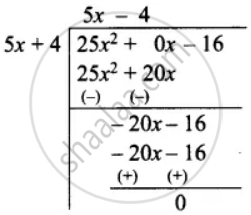Advertisements
Advertisements
Question
The base of a parallelogram is (5x + 4). Find its height if the area is 25x2 – 16
Solution
Let the height of the parallelogram be “h”
Base of the parallelogram = 5x + 4
Area of a parallelogram = 25x2 – 16
∴ Base × Height = 25x2 – 16
(5x + 4) × h = 25x2 – 16
h = `(25x^2 - 16)/(5x + 4)`
h = `((5x)^2 - 4^2)/(5x + 4)`
= `((5x + 4)(5x - 4))/(5x + 4)`
Height of the parallelogram = 5x – 4

APPEARS IN
RELATED QUESTIONS
Apply division algorithm to find the quotient q(x) and remainder r(x) on dividing f(x) by g(x) in the following f(x) = 10x4 + 17x3 − 62x2 + 30x − 3, g(x) = 2x2 + 7x + 1
Obtain all zeros of the polynomial f(x) = x4 − 3x3 − x2 + 9x − 6, if two of its zeros are `-sqrt3` and `sqrt3`
Find all zeros of the polynomial 2x4 + 7x3 − 19x2 − 14x + 30, if two of its zeros are `sqrt2` and `-sqrt2`.
Verify division algorithm for the polynomial `f(x)= (8 + 20x + x^2 – 6x^3) by g(x) =( 2 + 5x –3x^2).`
If (a-b) , a and (a + b) are zeros of the polynomial `2x^3-6x^2+5x-7` write the value of a.
Find all zeros of the polynomial 3x3 + 10x2 − 9x − 4 if one of its zero is 1.
Find the quotient and remainder of the following.
(8y3 – 16y2 + 16y – 15) ÷ (2y – 1)
The sum of (x + 5) observations is (x3 + 125). Find the mean of the observations
Which one of the following statements is correct?
Find k so that x2 + 2x + k is a factor of 2x4 + x3 – 14 x2 + 5x + 6. Also find all the zeroes of the two polynomials.
